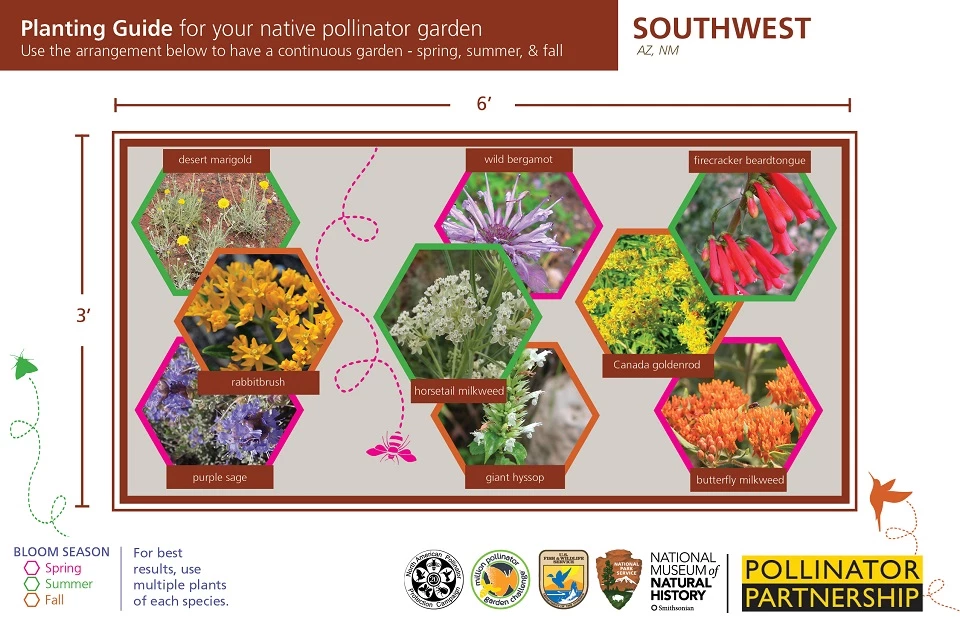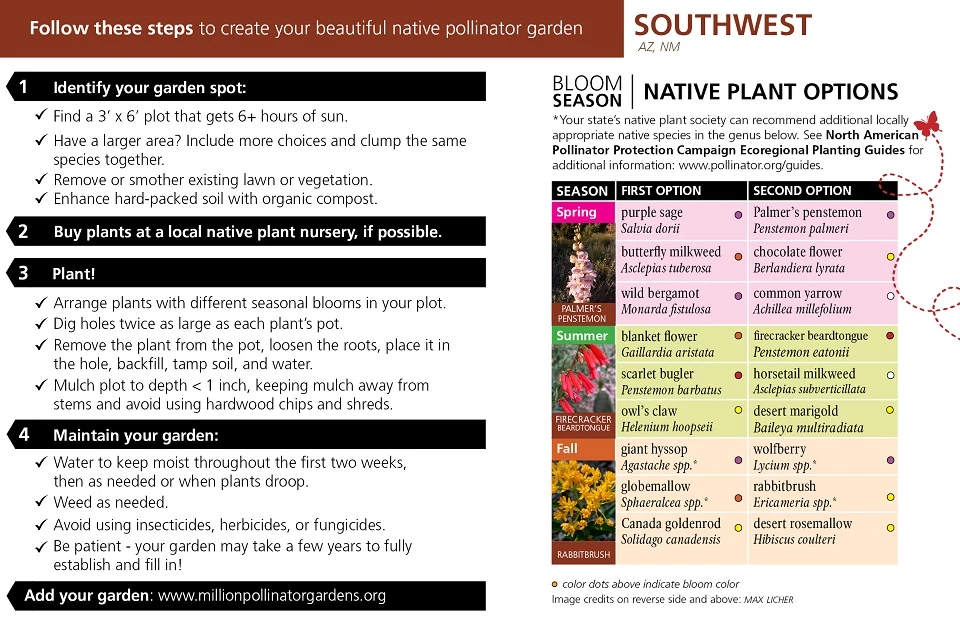Pollinator Planting Guide Cards - by EcoregionDownload and print a copy of the card appropriate for your region. Southwest Region Pollinator Planting Card (2-sided) 

Left image
Right image
Side 1:
Planting Guide for your native pollinator garden Use the arrangement below to have a continous garden - spring, summer, fall Northwest Region States that this card applies to: AZ, NM This card includes an illustration of a 3'x6' garden bed with a mixture of nine pollinator-friendly plants. The flower bed is set up with flowers for spring, summer, and fall. Arrange plants shorter on outside of plot. Flowers include: desert marigold (summer), rabbitbush (fall), purple sage (spring), wild bergamot (spring), horsetail milkweed (summer), giant hyssop (fall), firecracker beardtongue (summer), Canada goldenrod (fall), butterfly milkweed (spring) This card was produced by the following partners: North American Pollinator Protection Campaign, Million Pollinator Garden Challenge, U.S. Fish and Wildlife Service, National Park Service, National Museum of Natural History Smithsonian Institute, and Pollinator Partnership. Side 2: Follow these steps to create your beautiful native pollinator garden 1. Identify your garden spot: - Find a 3'x6' plot that gets 6+ hours of sun. - Have a larger area? Include more choices and clump the same species together. - Remove or smother existing lawn or vegetation. 2. Buy plants at a local native plant nursery, if possible. 3. Plant! - Arrange plants with different seasonal blooms in your plot. - Dig holes twice as large as each plant's pot. - Remove the plant from the pot, loosen the roots, place it in the hole, backfill, tamp soil, and water. - Mulch plot to depth <1 inch="" /> 4. Maintain your garden: - Water to keep moist throughout the first two weeks, then as needed or when plants droop. - Weed as needed. - Avoid using insecticides, herbicides, or fungicides. - Be patient - your garden may take a few years to fully establish and fill in! Add your garden: www.millionpollinatorgardens.org Native Plant Options: *Your state’s native plant society can recommend additional locally appropriate native species. See North American Pollinator Protection Campaign Ecoregional Planting Guides for additional information: www.pollinator.org/guides Season - Spring First options: purple sage [purple bloom] (Salvia dorii), butterfly milkweed [orange bloom] (Asclepias tuberosa), wild bergamot [purple bloom] (Monarda fistulosa) Second options: Palmer's penstemon [purple bloom] (Penstemon palmeri), chocolate flower [yellow bloom] (Berlandiera lyrata), common yarrow [white bloom] (Achiellea millefolium) Season - Summer First options: blanket flower [orange bloom], scarlet bugler [red bloom] (Penstemon barbatus), owl's claw [yellow bloom] (Helenium hoopseii) Second options: firecracker beardtongue [red bloom], horsetail milkweed [white bloom] (Asclepias subverticillatata), desert marigold [yellow bloom] (Baileya multiradiata) Season - Fall First options: giant hyssop [purple bloom] (Agastache spp.*), globemallow [orange bloom] (Sphaeralcea spp*), Canada goldenrod [yellow bloom] (Solidago canadensis) Second options: wolfberry [purple bloom] (Lycium spp.*), rabbitbrush [yellow bloom] (Ericameria spp.*), desert rosemallow [yellow bloom] (Hibiscus coulteri) |
Last updated: April 15, 2022
